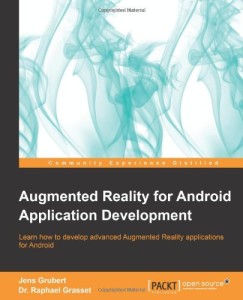Last summer, I was a technical reviewer for [amazon_link id=”1782168559″ target=”_blank” locale=”US” container=”” container_class=”” ]Augmented Reality for Android Application Development[/amazon_link]. The book has just been released, so I think it deserves a proper review. As you may have guessed, the book is all about augmented reality on Android.
The book is fairly short, which means it gives a very focused tutorial on developing augmented reality applications (think Layar). Through a number of examples you’ll get an introduction into:
- The Android development tools. Although a little prior knowledge is going to be useful, it should be possible to follow the book even if this is your first Android application.
- A bit of Android native development. This part is the section in the book that is going to cause the most confusion. And for good reason. As a first step, it’s probably best to just get the provided sources up and running and worry about changing them later on.
- jMonkeyEngine. I’ve not written enough about this cool project. It’s the easiest way to get into 3D if you are a Java programmer. Over the years this has become the behemoth of 3D Java development. They even have their own IDE now.
- Vuforia. An augmented reality toolkit. This is a closed source library, so you may want to handle with care. Besides this caveat, Vuforia is an awesome library to work with.
 In 7 chapters, the authors teach you how to use these tools in practical example projects that you can re-use directly in actual code. You’ll learn how to display the real world and place virtual objects on top. Next you’ll get an overview of the ways to obtain information of the real world (sensors, image recognition)
In 7 chapters, the authors teach you how to use these tools in practical example projects that you can re-use directly in actual code. You’ll learn how to display the real world and place virtual objects on top. Next you’ll get an overview of the ways to obtain information of the real world (sensors, image recognition)
It’s a lot of ground to cover in just 110 pages, so this brings me to my main gripe: some of the explanation is kept very short.
The native development parts may pose problems to many people as they require some minimal changes to C++ code.
And especially the explanation of 3D scenes is minimal. There’s also little to no information on how to actually make your 3D world attractive. Of course, there are many books that cover that.
Overall, Augmented Reality for Android Application Development is a well written and concise tutorial into this world of augmentation. The book will certainly get you started, but you may need to do additional research once you’ve found your direction.
Resources:
- Packt book page
- [amazon_link id=”1782168559″ target=”_blank” locale=”US” container=”” container_class=”” ]Amazon page[/amazon_link]